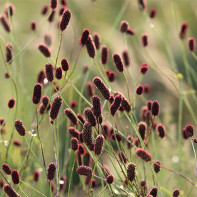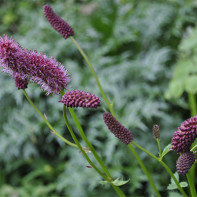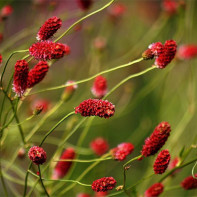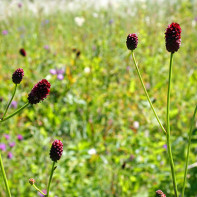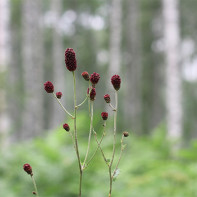Hemophilus: medicinal properties and contraindications
In the summer months in the fields and forest glades you can find grass with dark red fluffy cones, which complements any bouquet well. This is a hemoptysis, a medicinal plant known for its healing properties. Modern medicine uses thick rhizomes and roots emanating from them. Healers of different nations take all parts of this perennial for the preparation of potions.
- Chemical composition
- How it looks and where it grows
- Kinds
- Collection and storage
- The healing properties of the hemoptysis
- For women
- For men
- During pregnancy
- For kids
- Hemophilus in folk medicine
- Infusion for douching with erosion and fibromyoma
- Decoction for eye inflammation
- To stop bleeding in women
- Remedy for hemorrhoids (decoction)
- Worm Remedy
- Anesthetic lotion
- Grinding
- Fresh heartburn leaf
- Hemorrhage liniment from burns
- Herbal compress
- Infusion of dry leaves and stems
- Ointment (Korean folk medicine prescription)
- Types of healing compounds
- Infusion
- Tincture
- Decoction
- Tea
- Contraindications
- Interesting Facts
Chemical composition

Rhizomes of the plant are rich in beneficial substances. They contain about 23% of tannins, which have astringent and coagulating properties. In the root pulp of 30% starch, a lot of essential oil, there are natural dyes, organic acids (ellagic, ascorbic, gallic), natural pigment dyes. The plant has saponins - organic glycosides that do not contain nitrogen and have surface-active qualities, sterols. The hemophilus contains dozens of useful trace elements and macrocells that are absorbed by the human body (mg / g):
- aluminum (0.31);
- barium (5.70);
- boron (2.01);
- vanadium (0.12);
- iron (0.40);
- iodine (0.10);
- calcium (23.20);
- cobalt (0.04);
- potassium (5.80);
- magnesium (2.90);
- manganese (0.47);
- copper (0.59);
- nickel (1.15);
- lead (0, 06);
- selenium (1.39);
- strontium (6.14);
- chromium (0.03);
- zinc (1.02).
The ability to accumulate selenium, strontium, nickel and barium in high concentrations makes the medicinal hemorrhage a unique plant among other herbaceous species.
How it looks and where it grows
Medicinal hemoptysis is also called glandular or pharmacy. In Latin, the plant is referred to as Sanguisorba officinalis, which reflects its healing properties. Sanguis is translated as “blood”, sorbere - as “absorption”, “sorption”, “slurp”.
The genus of hemorrhages belongs to the Pink family. In Russian, grass has different names, many of which appeared hundreds and thousands of years ago. In the Russian regions, the plant is called a thigh, spring goldenrod, red-headed, mountain ash, black-headed, bloodsucker, sabine and two dozen more words.
The medicinal hemorrhage has a horizontal, thick, woody rhizome about 12 cm long. The fibrous, thin lateral roots depart from it. Their length reaches several centimeters. Upward from the rhizome leaves layering, covered with woody bark. A stalk grows out of it.
The stem is usually single, erect, grassy, bare, with vertical "ribs". The inner part of the stem is hollow, tubular. In the middle and upper part, branching into several additional stems occurs. The medicinal hemophilus grows in height to 35–100 cm.
In the region of the basal calyx, long leaves grow (from 7 to 25 pieces). They have a bright green color in the spring, but during the summer they dry up and turn brown. In the middle and upper part of the stem, the hemophilus throws out elongated, oblong, rounded (egg-shaped) leaves, 7–11 pieces on one petiole. They have a dense dark green color on the upper side and a dull bluish - on the lower. The serrated edges of the leaves look like a saw blade.
The medicinal hemoptysis begins to bloom in mid-summer and ends in August.Dates and duration depend on the region of growth: in highlands, flowering begins later and ends earlier than on the plains. The flowers of the plant are peculiar, they do not resemble a rose in any way, although Sanguisorba belongs to the corresponding family. These are dark red, dark purple cones located at the ends of long flower stems. Peduncles are often elongated, spike-shaped inflorescences are formed in some species.
The cones consist of many small flowers 1 to 3 cm long. The flowers are composed of four sepals and the same number of stamens, and there are no corolla petals. The ovary is formed at the bottom of the pestle.
The fruits of the plant are rounded brown "nuts" 2.5-3.5 mm long. They fully ripen in late August - early September.
Where grows
The range of the hemoptysis is extensive. The plant is widespread throughout Europe, in the temperate zone of Asia, in the forest and forest-steppe regions of North America. For comfortable growth, the hemophobia needs forest glades and edges, bushes, dry lands and water meadows. The plant feels good on the wet banks of rivers, springs and swamps. But in the desert regions it does not survive.
Hemophilia occurs in almost all areas of European Russia. The plant can be seen in the temperate zone of Siberia and Primorye, in forests and on grassy slopes of the Caucasus mountains.
Kinds
12 species of Sanguisorba grow in nature. The structure of the root system and the ground part are approximately the same. But the appearance and size of the leaves, as well as the type, shape, length and color of the inflorescences, vary greatly. The most common types of wild-growing hemoptysis are:
- glandular;
- alpine:
- Sith;
- Canadian
- small flowered;
- thin-leaved;
- Khakusan;
- gorgeous;
- dumb.
Glandular hemorrhage is widespread in the Far Eastern regions. It is characterized by reddish, "rusty" pubescence, but otherwise completely identical to the drug.
Khakusan is widespread in the Japanese archipelago, in mountainous areas and along river banks. The bush grows to 80 cm, gives a very lush, beautiful inflorescences. In the midst of flowering, panicles drop under their own weight. The leaves of the Khasuan hemorrhage are wide, the inflorescences are bright pink, covered with long, erect fluffy stamens.
Alpine is found in the high meadows of Mongolia, Central Asia and Siberia (Western, Eastern Sayan Mountains). This variety has long, drooping inflorescences of a greenish, yellowish-green color, sometimes with a reddish color on the tips of the sepals. The bush grows to a height of 45–80 cm. The leaves of the alpine hemorrhage grow for a long time, at the beginning of flowering, their length does not exceed 2.5–3 cm, per month they are extended to 7–8 cm.
Sikhtinskaya is found in alpine meadows of the Far Eastern ranges. This hemorrhage resembles an Alpine one, but grows to a height of 1.5 m. The inflorescences of this species are greenish-white, large, up to 12 cm in length and up to 2 cm in volume. At the end of flowering, panicles extend and wilt.
Canadian Hemophilus grows up to 2 m. It occurs in moist glades, moist meadows of the North American continent. This is a beautiful plant with erect, strong stems and large white inflorescences.
The dull hemorrhagus grows in the mountainous regions of Japan. It grows to 1 m and blooms with bright pink inflorescences. A kind of stupid hemorrhage is the Alba variety, which gives long snow-white inflorescences.
Small-flowered is distributed in Japan, northeast China and the Russian Far East, mainly in humid river valleys. This species has narrow, long leaves 6–10 cm wide. During flowering, the plant is covered with a large number of long white inflorescences. The panicle length reaches 7 cm or more. The height of the bush is on average 100 cm.
Thin-leaved is a hybrid that appears during over-pollination of small-flowered and medicinal species. The plant reaches 180 cm in height. During flowering, the bush is covered with lush, oblong panicles of pink color.It does not always stand out as a separate species, but the hybrid was included in the Flora of the USSR directory under its own name.
The magnificent hemorrhagic is a resident of the Russian Far East. This species grows on rocks, indigenous limestone outcrops. Compared with the hygrophilous “relatives”, this hemorrhage is not high, the bush rarely stretches more than 30–50 cm. The leaves of the plant are greenish, bluish. During abundant flowering, the bush is densely covered with fluffy, shaggy panicles of pink color.
Collection and storage
Wild-growing hemorrhage is harvested in regions where the plant is widespread. These are Tatarstan, the southern and middle Urals and some parts of Siberia. Raw materials are rhizomes and roots originating from them.
For harvesting, choose healthy, strong bushes five years of age or older. Some herbalists recommend digging out the roots at the height of flowering when the inflorescences turn dark red, others at the end of the flowering period when the seeds begin to ripen.
In the wild, they do not dig out all the roots in a row, 1-2 plants are left for 10 m² in order for the species to resume. You can’t get rhizomes in the same place every year. Biologists recommend re-harvesting at a specific site every 10 years, otherwise the population will not recover, and the rhizomes of new plants will be thin.
The roots are dug with a bayonet shovel with a sharp rounded blade. They dig in at a distance of 15–20 cm from the stem, deepening the instrument to the length of the bayonet. If you dig closer, you can cut off the side roots and damage the central one, since the root system of the plant is horizontal.
From the loosened earth, the hands choose the root part. Then cut the stem and carefully shake off the lumps of soil. The roots are washed in clean cold water, then cut into pieces 15–20 cm long and laid out to dry. Upon contact with air, the slices quickly oxidize and darken, so rather large pieces are prepared for drying. First, the raw materials are ventilated (dried) under a canopy, in a well-blown place. Rainwater should not fall on the roots.
Then placed on a permanent place of drying. High temperatures do not destroy the beneficial substances that make up the hemophilus. Therefore, the raw materials can be dried in an oven (temperature 40-50 degrees), in a fruit dryer and in the sun. It is impossible to carry out drying on a grate over an open fire, on an iron sheet, a baking sheet. If the roots turn black, become charred, then the hemophilus will lose its healing properties.
Roots are considered dried if they do not bend, but break. The raw material is odorless and has a specific astringent taste. The finished product is stored in canvas bags, paper bags or boxes, at normal (room temperature), without direct sunlight. Shelf life of raw materials is 5 years.
The healing properties of the hemoptysis
The healing properties of the hemoptysis provide dozens of useful substances that make up the roots. Terrestrial greens also have healing properties.

- The tannins (tannins) present in the roots of the plant have a hemostatic and astringent effect. They react with proteins, causing them to coagulate. Therefore, on the surface of the wounds, mucous membranes, a protective, waterproof film is formed, that is, tanning occurs, and the vessels narrow.
- The effective antiseptic effect of the plant is due to the complex work of substances. Hemophilia has a detrimental effect on a number of microorganisms.
- The substances that make up the roots have anti-inflammatory and analgesic effects on the body. The product effectively affects the intestinal mucosa, blocks spasms, slows peristalsis and eliminates pain.
- Due to the large number of micro and macro elements, the presence of useful organic acids, plant materials are used as a general strengthening, healing and tonic drug.
- Organic acids actively break down fats and help maintain an optimal water-salt balance.
- Ascorbic acid (vitamin C) is an active antioxidant that is involved in many biochemical processes of the body, the synthesis of hormones, and tissue regeneration. This substance strengthens capillaries and is involved in the synthesis of collagen, cholesterol metabolism. Ascorbic acid is an anti-allergic and anti-inflammatory substance that activates collagen production and improves liver function.
- Starch is found in rhizomes in large quantities. This substance has an enveloping effect on tissues and mucous membranes. Starch is a stimulant for the production of insulin, and also reduces the content of "bad" cholesterol.
- Sterols (derivatives of steroids) reduce the manifestations of allergic reactions and control appetite. These substances are responsible for the normal functioning of the heart.
- Carotenes are involved in metabolic processes, normalizing certain chemical reactions. These substances stimulate bone repair.
- Hemophilus essential oil has a calming effect on the nervous system and improves metabolism.
- Micro and macro elements are involved in the work of all body systems and in metabolic processes. These substances are important for the proper functioning of internal organs.
Official medicine recognizes the healing properties of the roots of the hemorrhage. Doctors prescribe decoctions, infusions, extracts and other drugs to patients.
Astringent qualities allow the successful use of a hemoptysis for intestinal bleeding that occurs during poisoning and some infectious diseases, hemorrhoids. Together with the drugs, the hemophilus is indicated for pulmonary hemorrhage, when the period of exacerbation has ended.
The hemorrhage destroys dysenteric amoeba, salmonella, typhoid parathyroid bacteria, E. coli. It is active against bacteria that cause gingivitis and stomatitis, suitable for the treatment of trophic ulcers.
Means from the roots of the plant suppress the vomiting reflex, have an anticonvulsant effect. They are recommended to be used internally and externally in the treatment of burns, and to wash the wounds. Solutions and infusions are recommended for the treatment of inflammatory eye diseases (blepharitis, conjunctivitis). The hemoptysis has a fixing effect, it is recommended in the treatment of diarrhea.
The plant has a therapeutic effect in case of digestive disorders caused by various reasons, including a violation of the diet, indigestion, gastritis. A hemoptysis is prescribed orally for colitis, inflammation of the bladder, giardiasis, and inflammatory diseases of the kidneys.
For women
The hemorrhagic has shown itself well as an additional treatment for gynecological diseases. The astringent and bactericidal properties of the plant make it possible to use self-prepared drugs for uterine, heavy menstrual bleeding, as well as for pain on “critical days”. They are taken orally, in the form of infusions or decoctions. Drugs constrict blood vessels and contract the uterus.
Blood-based agents are used for cervical erosion and uterine fibroids. For treatment, douching is done. Decoctions and infusions are also taken orally for the prevention of fibroids.
Bacterial vaginosis is treated with a hemoptysis. This is a non-inflammatory disease in which the composition of the microflora changes. For treatment, douching is used. In the same way, the drug is used in the treatment of trichomonas colpitis (along with medications).
For men
The list of male diseases has many ailments that are accompanied by inflammation. In this case, the doctor may recommend taking medications from the hemoptysis. This, for example, acute and chronic prostatitis. In the case of "universal" diseases, men and women use the hemoptysis in the same way.
During pregnancy
Pregnant women should not be treated with a hemoptysis.Infusions and decoctions act as antispasmodics, which can complicate the course of pregnancy. Nursing mothers should also remove the hemoptysis from their first-aid kit. Tannins, esters can change the taste of milk and worsen its quality, as a result of which the baby will abandon the breast.
For kids
Hemophilia can be treated even for infants younger than a year. But before using a herbal preparation, you need to consult a pediatrician.
- A hemoptysis can be given to children with intestinal infections (dysentery, infection with bacteria of the typhoid parathyroid group).
- Decoctions of hemoptysis are prescribed for the treatment of diarrhea (toxic, gastrogenic) and enteritis.
- Herbal therapeutic solutions are indicated for gingivitis, stomatitis, they rinse the oral cavity and gums. For gums, an infusion of strong concentration is better.
- A doctor may prescribe a hemorrhage if a child has cramps or intestinal colic.
- Decoction of the root is recommended to treat scratches, burns, ulcers, poorly healing wounds.
In the past, the aroma of blooming hemorrhagic was considered healing. In the 17th century, it was recommended that children with neurological diseases be inhaled directly on the field.
Hemophilus in folk medicine
Traditional medicine treats many diseases with a hemoptysis. Healers store and pass from generation to generation recipes for decoctions, infusions, ointments, powders, and other preparations made from this plant.
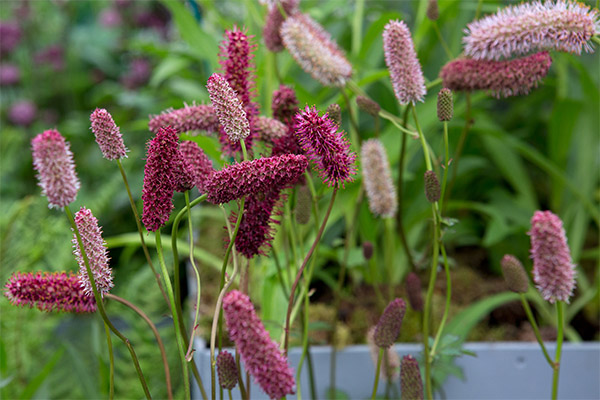
Infusion for douching with erosion and fibromyoma
Half a glass of dried root is poured with boiling water (700-800 ml). The vessel is closed and insisted for at least 4 hours. After that, the solution is carefully filtered through a tissue and douched. The frequency of the procedure is agreed with the doctor.
Decoction for eye inflammation
Inflamed eyelids and cornea are treated with chilled broth. A tablespoon of chopped rhizomes is poured with a glass of water, boiled for a quarter of an hour over low heat. Then close the lid, cool and filter through several layers of fabric. In the solution, particles of the root that can injure the eyes during the procedures should not float. If necessary, filtering is repeated several times. Eyes are washed several times a day using a piece of cotton wool or a cotton pad. In this recipe, you can brew sage along with a hemoptysis.
To stop bleeding in women
Half a liter can is filled with finely chopped dried rhizomes. The vessel is poured to the top with vodka (but it is better to take medical alcohol with a strength of 70%). The tool is insisted in a cool, darkened place for at least 2 months (but you can withstand three). Treatment is carried out as follows: 5–40 drops of tincture are drunk 5 times a day (after eating).
Remedy for hemorrhoids (decoction)
A glass of water is boiled in a mug and a spoon of chopped blood-soup roots is poured into it. The ingredients are mixed and let the broth boil for another half hour. The product is covered and simmered for 3 hours, then filtered through a cloth or several layers of gauze. Broth in any quantity is poured into a warm sitting bath, and also taken orally (on an empty stomach, a tablespoon per day).
Worm Remedy
This ancient remedy is effective for expelling worms. In a half-liter mug with hot water put a glass of crushed rhizomes (without top). The product is put on a small fire and boiled for a quarter of an hour. Then cool and filter. Drink the solution in the morning, in four divided doses (before meals). History has kept information that in the 16th century this grass was used to rid horses of worms.
Anesthetic lotion
To prepare lotions you will need a cup of fresh, finely chopped leaves of the hemorrhage. In winter, they can be replaced with dry leafy raw materials (you will need a few teaspoons). Prepared grass is poured on gauze and tied with a knot. Gauze is immersed for one minute in freshly boiled water, then put on a clean plate and cooled to a comfortable temperature. The lotion is placed on a sore joint or muscle, then covered with a towel. The compress is held for up to an hour or more.
The same lotion has a regenerating effect after sunburn.
Grinding
This home remedy is good for relieving pain in joints and muscles, as well as a temporary remedy for toothache. Grinding is prepared on vodka or alcohol with a strength of 40 degrees. Take the dry raw materials of the hemorrhagic, coy, bought, bluehead (on a spoon) and grind it. Add 2 of the same measures of flowers of lilac and oak bark. Herbs are poured into a jar and filled with a glass of vodka, hermetically closed. Grinding insist in the room, without access to sunlight for two weeks, then put in the refrigerator and apply as necessary. The hemorrhage is infused for a long time - 2-3 months.
Fresh heartburn leaf
Folk healers recommend hemoptysis as a remedy to reduce heartburn. Fresh leaves are plucked from the plant and chewed, and then swallowed. A few leaves help get rid of a burning sensation in the esophagus.
Hemorrhage liniment from burns
For cooking, you will need crushed roots and 80 ml of alcohol (or a ready-made alcoholic extract of a blood-thistle from a pharmacy), 45-50 ml of liquid oil (olive, petroleum jelly or sunflower). The ingredients are mixed in a clean bowl until completely dissolved, a couple of drops of camphor and 10 g of berberine are added to the emulsion obtained. Liniment can lubricate burns if there is no damage to the skin.
Herbal compress
Compress can be made by taking fresh or dry leaves, stems, flowers. The raw materials are finely chopped and poured with boiling water. Then let cool and lay on gauze evenly. Top cover with a cloth or another piece of gauze. Compress is applied to wounds, ulcers, scratches, it can be used for burns of 1 degree.
Infusion of dry leaves and stems
It is recommended to use if there are no rhizomes of the plant. A glass of dry grass is poured into a half-liter container and poured with cool, pre-boiled water. The tool is insisted from 8 to 10 hours. The infusion is used as an anti-inflammatory drug, it is drunk up to four times a day (before each meal).
Ointment (Korean folk medicine prescription)
The tool is intended to treat eczema. Rhizomes are heated to the initial signs of carbonization and pounded in a mortar to a powder state. After that, measure 3 servings of powder and 7 servings of petroleum jelly and mix thoroughly. The resulting mass is applied to the affected skin in the morning and evening for a week. During this time, a healing effect should be manifested.
Types of healing compounds
Decoctions, teas and infusions for the treatment of various diseases differ in the concentration of raw materials, the amount of water, the duration of heat treatment and infusion. The frequency of use and the effectiveness of the drug depend on the concentration. It is best to cook homemade preparations in strict accordance with the recipe given on the pharmacy packaging of the hemorrhage.
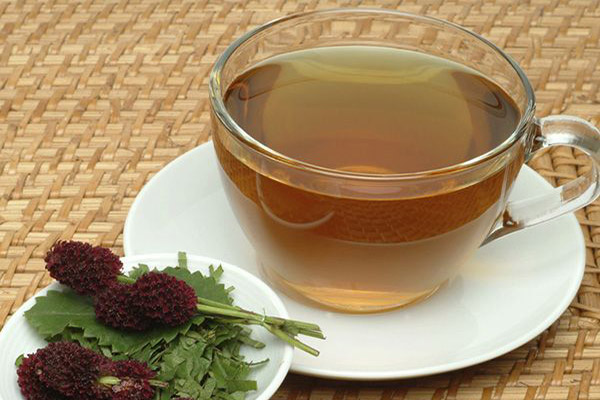
There are general rules for the preparation of infusions, teas and decoctions, which are the same for all types of plant materials. Official medicine recommends following the recommendations of reliable plant suppliers.
Infusion
Infusions are prepared by pouring dried raw materials (less often - fresh) with hot water and holding for several hours. There are two ways to prepare such medicines.
In the first case, the raw materials are simply poured and insisted, in the other, they are poured with hot water (it is recommended to use metal enameled dishes) and placed in a "water bath". The water in the bath is heated to a boil and boiled for as long as the producer of plant materials indicated. Then the dishes with the infusion are removed and cooled.
The rhizomes of the hemophilus need not be heated in a water bath. The raw materials are measured with a spoon, poured into a vessel, poured with boiling water and simply withstand a certain time (at least a quarter of an hour). Infusions are also prepared if the hemorrhage is packaged in bags.
If the solution turned out to be thick (for example, for washing the eyes or burnt skin), add boiling water.
Tincture
To prepare the tincture you need alcohol or ordinary vodka. You can use any of these ingredients. The preparation technology is simple. Dry raw materials (rhizomes) are measured with a spoon and poured into a glass jar. Concentration depends on the recipe of a particular author. Then pour alcohol and close the sealed lid.
Tincture does not like sunlight, so it needs to be removed away, on a darkened shelf or in a corner, best of all - in a cool place. After that, the jar is cleaned in the refrigerator. The frequency of use of the drug, as well as the dosage, is best agreed with the doctor.
Decoction
Medical sources do not recommend preparing decoctions by boiling raw materials in a pan. They are prepared in the same way as infusions. The grass is poured into an enameled saucepan, poured with hot water and placed in a water bath.
What is the difference between a prepared remedy and an infusion? The answer is simple: holding time in a water bath. In some cases, it is an hour or more. As a result, extraction (extraction, extraction) of useful substances is more intensive, and the product is more concentrated.
This must be taken into account when preparing infusions from complex herbal preparations. You can not enter into the composition of the decoction of the grass, which is not recommended to be subjected to prolonged heat treatment (like rhizomes of the blood crust).
Tea
To make tea, vegetable raw materials are poured with boiling water and kept for several minutes. A hot drink is immediately ready to drink. As the tea leaves are used herbs, leaves, shredded roots, berries.
When preparing tea from the hemoptysis, both dry rhizomes and leaves, or a mixture of them, are used. For a large tea mug with a volume of 250-300 ml, 1-2 teaspoons of plant material are enough. They are poured with boiling water. Tea is ready in five minutes. With treatment, you can drink two mugs a day.
Contraindications
Medicines based on hemoptysis are not prescribed for constipation, high blood pressure, cerebral vasospasm. They can not be taken with thrombophlebitis and increased blood clotting.
Treatment with this herbal remedy is contraindicated if a person has an individual intolerance to the substances that make up the plant. Allergic reactions are manifested by a rash, redness of the skin, nausea, in severe cases - swelling.
Interesting Facts
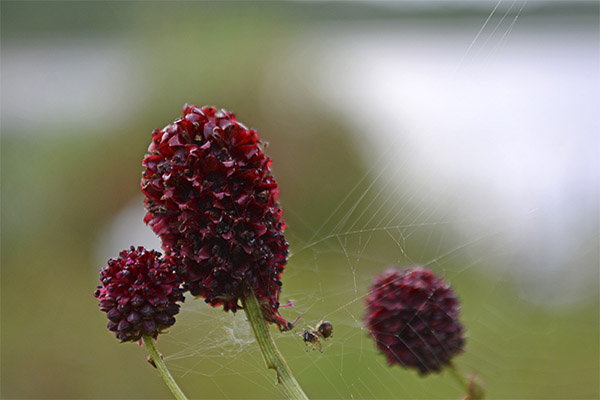
- Hemophilus is an amazing herb containing dozens of nutrients and elements. It not only cures diseases, but looks beautiful and is actively used by florists. An elegant, beautiful plant is included in exquisite bouquets and floral arrangements.
- Popular breeding varieties of hemorrhages are Chocolate Tip, Red Zander, Pink Braces, Mensisa, Rhesus, Tanna, Pink Tanna. Interestingly, wild representatives of this genus live up to 40 years, breeding gardens - up to 8 years. All types of wild-growing hemoptysis are resistant to fungal infection and viral diseases. These are winter-hardy perennials that grow well in partial shade and in open areas.
- Hemophilia belongs to edible herbs. Almost all parts of the plant go to food. Rhizomes saturated with starch can be boiled in water or in milk. Leaves are suitable for salad. Greens has a pleasant cucumber taste and a peculiar aroma of walnut. Juicy spring leaves are especially delicious. They are quite soft and not scratchy. Leaves can also be added to okroshka and hot soups, but only as a fresh seasoning. Heating affects the taste of greens and destroys the aroma.
- In homemade soft drinks, you can add not only ginger, but also leaves of the hemorrhage. They will give the drink a new flavoring note. In lemonades, the blood of the hemorrhagic goes well with mint. In meat dishes, it is added along with tarragon, parsley and rosemary.
- In eastern cuisine, not only leaves, but also the flowers of this plant were used. They improve the taste of roast and first courses.
- Hemophilus greens are added to cheeses, this plant diversifies sauces and meat gravy. From green leaves they even make original vinegar, which has a special fresh aroma.
«Important: all information on the site is provided exclusively in fact-finding purposes. Before applying any recommendations, consult with a profile specialist. Neither the editors nor the authors are liable for any possible harm caused materials. "

